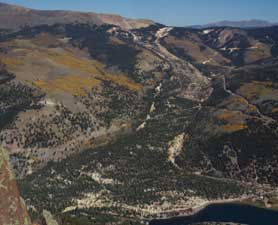
Slow moving landslides may be controlled by tides within the atmosphere, Nature Geoscience reports, writes Ian Randall
Geoscientist Online 12 January 2010
From a study of the Slumgullion landslide, in Colorado's San Juan mountains, Schulz, Kean & Wang of the United States Geological Survey propose that falling air pressures reduce the drag on slip surfaces and cause the slide to begin creeping movements. As the Slumgullion slide teeters perpetually on the edge of failure, a very slight lowering of the normal stress reduces friction sufficiently to initiate movement. A variation of only 0.5 KPa is thus enough to achieve failure.
Slumgullion slips at an average speed of 1cm per day and now reaches 3.9km down the mountainside. In earth flows, the shear is spread across the failing body, and movement occurs in the manner of an extremely viscous fluid. Researchers now believe that Slumgullion has slips confined to narrow regions of shear at its outer edges, and that the deformation follows intermittent episodes of block-slide processes and periods of inactivity.By comparing detailed records of slip with air pressure variations, the researchers demonstrate a clear correlation of diurnal movement with daily atmospheric changes – the movement occurring around three hours after periods of lowest pressure.
Not a widely recognised phenomenon, the atmospheric tides to which the slide is responding are small changes in air pressure brought on by solar heating, and occur on a 12-hour cycle. Tides are strongest at higher altitudes and at lower latitudes, where the warming effect of the sun is greatest. This may help to explain Slumgullion's susceptibility to atmospheric tides, because it is situated 3000 metres above sea level. Schulz et al. also believe that the pressure fluctuations that accompany rapidly moving storm systems could also play a role in triggering landslide movements.
Tidal cycles have also been recognised as causing mass movements along shear surfaces associated with earthquakes and glacier flow. However, although atmospheric tides may play their part in other landslides similar to Slumgullion, they are unlikely to have a major impact on the much grander, and more familiar catastrophic movements seen on steeper, more steeply inclined slopes. The triggers of such larger landslides are better understood, with heavy rainfall often given as the major cause of slips. Water seeping into the ground increases hydrostatic pore pressures and by thus reducing the frictional strength along the shear surfaces, causes rock masses to fail more easily.
Despite its generally slow rates of creep today, the Slumgullion slide is thought to have begun life between 800 and 900 years ago as a catastrophic flow, large and sudden enough to enough to dam the valley of the Gunnison river. The resulting mass of water that was impounded, Lake San Cristobal, is today one of Colorado's largest lakes.
Trivia: The Slumgullion Landslide got its peculiar name from the resemblance of the local yellow loam soil to Slumgullion stew.
Reference
- Landslide movement in southwest Colorado triggered by atmospheric tides William H. Schulz, Jason W. Kean, Gonghui Wang Nature Geoscience 2, 863-866 (1 November 2009)